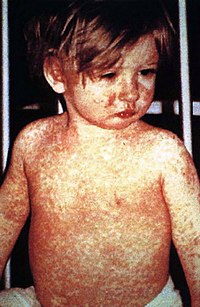
Photo from wikipedia
To the Editor, Osteoma cutis is a benign cutaneous lesion characterized by bone formation in the dermis or subcutaneous adipose tissue.1,2 It may either be primary or coexist with other… Click to show full abstract
To the Editor, Osteoma cutis is a benign cutaneous lesion characterized by bone formation in the dermis or subcutaneous adipose tissue.1,2 It may either be primary or coexist with other skin tumors. Seborrheic keratosis are benign lesions and may easily be diagnosed with macroscopic examination. Herein, we would like to present a case of collision tumor consisting of osteoma cutis and seborrheic keratosis after botulinum neurotoxin typeA (BoNTA) injection. 44yearold male patient admitted to the dermatology outpatient clinic due to a dark, enlarging papule in the glabella, which he had noticed for a month. The patient had 6 units of BoNTA injection in glabella two months prior to the lesion. Dermatologic examination revealed a hard, hyperpigmented, solitary 2– 3 mm papule in his glabella (Figure 1A). Border and morphological asymmetry, hairpin and glomerular vessels in the center, and hyperpigmented dots and globules in the periphery were noted in dermoscopic examination (Figure 1BC). Although these dermoscopic features resembled seborrheic keratosis, the presence of asymmetric structure and hyperpigmented globules necessitated total excision to be able to rule out melanoma. The laboratory tests were normal. Histopathological examination revealed acanthotic and clonal type seborrheic keratosis and osteoma cutis in the base of the lesion (Figure 2). There was no seborrheic keratosis or osteoma cutis on the face or body of the patient before the injection, and no recurrence was found for two years of followup. Secondary osteoma cutis is often seen in adults between 20 and 80 years of age and more frequently in women. It has been reported to be related to basal cell carcinoma, trichoepithelioma,
Journal Title: Journal of cosmetic dermatology
Year Published: 2021
Link to full text (if available)
Share on Social Media: Sign Up to like & get
recommendations!